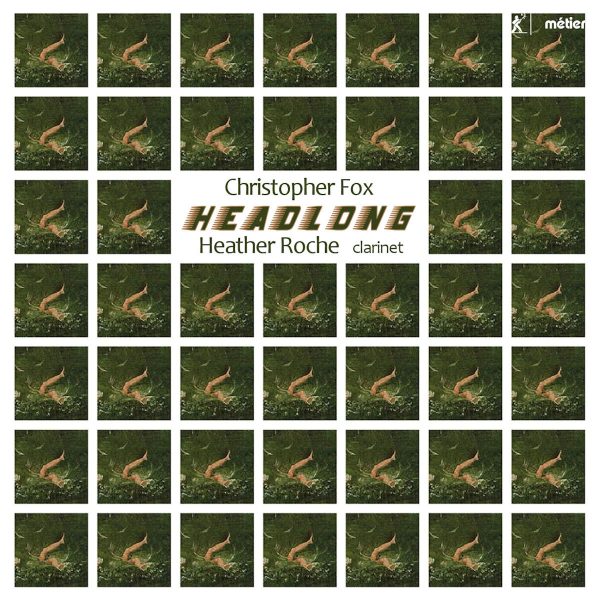Nieuwe Noten
The English composer Christopher Fox likes to work intensively with performers. For a long time he has been working with ensembles such as the Ives Ensemble and Apartment House, the vocal ensembles The Clerks and EXAUDI and with individual musicians such as the pianists Ian Pace and Philip Thomas – the latter played pieces from ‘Senza Misura’ during the last edition of November Music – cellist Anton Lukoszevieze and the clarinetists Roger Heaton and Heather Roche. The latter recently released an interesting CD for Métier with works for clarinet that cover the last 35 years of Fox’s career.
Christopher Fox is from the north of England but currently lives in London. He studied with Jonathan Harvey and Hugh Wood among others, gave lessons in Darmstadt during the Ferienkurse für neue Musik and is currently active as a professor at Brunel University. He has now built up a decent oeuvre of which we find an interesting part on this album.
The oldest pieces, long engagements written with performers in mind, were written for the clarinet player Roger Heaton, who Fox got to know by coincidence at the end of the 1970s. ‘Divisions’ from 1980 is the second of three pieces that emerged from this friendship. The score for this piece for bass clarinet consists of three pages with very different music per page. The performer may move freely between them and may improvise further in order to bring about the transition between the pieces. It is a special, predominantly rather subdued piece in which the sound richness of the bass clarinet stands out.
‘… or just after’ from 1984, Fox also wrote for Heaton. He derived the title from a poem by Wallace Stevens, ‘Thirteen Ways of Looking at a Blackbird’. It is a very quiet piece for clarinet, where the power clearly lies in the nuanced game. Roche brings it with a nicely measured, warm sound. ‘Stone.wind.rain.sun’ was composed in 1989 for the two clarinetists, Alan Hacker and Lesley Schatzberger, of the then London New Music Ensemble of Michael Blake. However, the current technique makes it possible for Roche to play the piece on her own, and that goes for several pieces on this album. The composition is part of a series of wind instruments in which Fox pictures the north of England. It is a fascinating dialogue that Fox has created for the two clarinets here. A fairly simple melodic pattern appears in various absorbing forms.
There are also several versions of ‘Straight Lines in broken times’. Fox wrote this version for Heaton in 1994 for two bass clarinets and tape. Low bass notes of two clarinets were sampled and two other bass clarinets play their lines. This piece is a true polyrhythmic sound festival, in which the complete spectrum of the bass clarinet is presented and the experimental sounds that are produced here sometimes seem to come from the zoo. Fox wrote ‘Escalation’ for the 50th birthday of the man who had premiered all those clarinet pieces until then, Heaton. Originally it was scored for clarinet, but Roche found the bass clarinet a better fit and thus plays it here. It is a rather strange piece in which the clarinet subtly makes a kind of loop, indeed as if a staircase is descending. ‘Headlong’ was originally written for oboe and here too Roche Fox convinced that another instrument, in this case the E♭ clarinet, would also work. Pretty simple-sounding patterns are combined here with rhythmic electronics that are reminiscent of the pulsating sound of old video games. Fox demonstrates a clear sense of humor with this piece.
‘Early One Morning’ from 2014 is written for every conceivable duo of woodwinds and Roche chooses the combination of clarinet and bass clarinet. The inspiration was the sculpture ‘Early One Morning’ by Sir Anthony Caro from 1962, shown in Tate Modern in London. The core of the piece is formed by a shared note and a number of notes in clean mood around it. But in practice there is a long, high drone-like sound that, like Caro’s sculpture, is built up like a central axis with satellites around it.
Finally, ‘Unlocking the grid’ from 2015 is another homage to a visual artist, in this case Agnes Martin, who died in 2004. Grids always play a major role in the paintings of this artist, hence the title. This piece can also be performed by any woodwind, in combination with three channels of previously recorded samples. As with ‘Early One Morning’, Fox is also primarily concerned with the sound of the instrument. In this sense, the last two pieces deviate from his earlier work for this instrument.
Roche clearly has a feeling for the rich world of Fox’s music for clarinet and plays the compositions one by one in a very convincing way.
@divineartrecordingsgroup
A First Inversion Company
Registered Office:
176-178 Pontefract Road, Cudworth, Barnsley S72 8BE
+44 1226 596703
Fort Worth, TX 76110
+1.682.233.4978










![Listen to the full suite of Marcel Dupré’s Variations Sur un Noël, Op. 20 from Alexander Ffinch’s #Expectations release today! listn.fm/expectations [in bio]](https://scontent-dfw5-1.cdninstagram.com/v/t51.71878-15/588904367_2327488161082898_8709236950834211856_n.jpg?stp=dst-jpg_e35_tt6&_nc_cat=105&ccb=7-5&_nc_sid=18de74&efg=eyJlZmdfdGFnIjoiQ0xJUFMuYmVzdF9pbWFnZV91cmxnZW4uQzMifQ%3D%3D&_nc_ohc=AiUKMpkx7d0Q7kNvwGGzF4A&_nc_oc=AdkXZoNG_aC5XlImpsh5RnvRT-FstV4-TdHX1TQvASqHP56721gdCuA_DWR1ACeCz32jhDMpJi8tQ0kwbGjwVA2V&_nc_zt=23&_nc_ht=scontent-dfw5-1.cdninstagram.com&edm=ANo9K5cEAAAA&_nc_gid=WDs0zosp4eS4uVSbpNu4YQ&oh=00_AfnDxCwBSovVpVGX3ZvqqwBGOjEbcFAM4oT16txwrmBcKg&oe=6950CBEA)

![“the ‘Manteca’ Paraphrase – a rare foray into the two-piano medium but here played double-tracked – exudes a panache of which Dizzy Gillespie would surely have approved.… [a] recital well worth investigating.” —Gramophone Magazine with high praise for Ophelia Gordon's debut release, Kapustin: Between the Lines!](https://scontent-dfw5-3.cdninstagram.com/v/t51.82787-15/598796470_18303255136283342_540941604740887837_n.jpg?stp=dst-jpg_e35_tt6&_nc_cat=108&ccb=7-5&_nc_sid=18de74&efg=eyJlZmdfdGFnIjoiRkVFRC5iZXN0X2ltYWdlX3VybGdlbi5DMyJ9&_nc_ohc=qJeKeEK7ScQQ7kNvwEX0AD9&_nc_oc=Adm5n0E9HX-UrpRkUbhNaNaNlvX51iMZXwHkJA9-vJBfrtosWdxbK0l43aooOgQR8uPqB1TSoTAiuPJOs4XwSeJ7&_nc_zt=23&_nc_ht=scontent-dfw5-3.cdninstagram.com&edm=ANo9K5cEAAAA&_nc_gid=WDs0zosp4eS4uVSbpNu4YQ&oh=00_AfmRvqvOc8V0flycY76XpHX29ZSyYBTUPz3fOSDam0Mm0g&oe=6950A644)